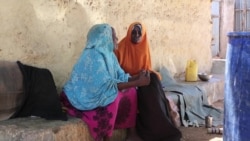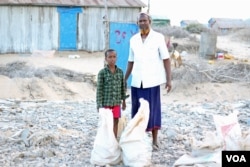Ibrahim Hassan, 49, was delighted to have a home after living more than 20 years in Kenya's Dadaab refugee camp.
“All my life I never slept in a house of my own," he said. "Half of my life I spent in a refugee camp dependent on aid agencies. February this year, I bought a [piece of] land and built it.”
But Hassan’s dream was short-lived. This past October, a year after he returned to Somalia from the largest refugee camp in the world, he was told to tear his home down.
“I was told to move out of my house. The reason authorities gave me was that the land is a disputed one and the person who sold it to me was not the genuine owner,” he said while collecting structural remnants to build a new home.
“I was compensated with another piece of land," he said. "But it’s disheartening for a refugee and a poor man like me to be evicted from his original home. It’s still a difficult move."
Rough return
Hassan was among the first occupants of Dadaab, which was opened in 1991 to accommodate refugees from Somalia's civil war. At one point, the camp population swelled to more than 400,000.
Earlier this year, Kenyan officials said that the camp would close on November 30, only to renege on the deadline. Just this week they said the camp would remain open until May, to allow Somali authorities extra time to improve security and services for returning refugees.
UNHCR, the U.N. refugee agency, has been helping Somalis return to their former homes. To start a new life, Hassan, a father of nine, used all of his savings and stipends he received from UNHCR in Dadaab and local authorities in Kismayo.
Land disputes
Most returnees, however, have found it difficult to secure reliable food, health care and shelter, and Hassan, like 75 other families, are affected by ongoing land disputes in Kismayo.
Mohamed Noor, vice chairman in the Jubaland Refugee and Internally Displaced Persons agency, says it’s up to the government to sort out the land disputes and issue titled deeds to minimize violence.
“In the last 20 years, there are many people who claim to own land and conflict has risen from this," Noor said. "It’s the duty of the government to look into this conflict arising from land ownership in the country to make sure people get what is rightfully theirs, and accommodate others who do not own land.”
No place to call home
Sokorey Guhad returned in October 2015. She and her mother were the first people to register for the repatriation process that began that same year.
“We fled from Kismayo during drought and conflict" in 2011, she said. "I fled with my mother and older sister. For the last five years, we were used to free shelter, food and clean water. When I was coming back to my home, I was afraid I might be caught with the same problem that made me flee."
"After two days and two nights, I left the transit center and moved to the city to a relative's house," she added. "We don’t have a home here. I still live with relatives."
When Guhad fled with her family, the Somali militant group al-Shabab was in control of Kismayo. Humanitarian assistance was beyond reach as the group banned aid agencies in the areas it controlled.
Limited services
In October 2012, the militant group lost the city to African Union troops and Somali government forces but it still controls villages surrounding the city.
Kismayo is largely perceived as a safe place for Somali refugees to return to, but authorities admit the city lacks essential services to support them.
“The returnees had a good life, good health services, and their children were in school getting an education [in Dadaab]," said Noor of Jubaland Refugee Agency. "In Kismayo, their destination, there was nothing.”
Others, however, see the port city as a place to rebuild their lives.
Ibrahim Bundid, another victim of the 2011 famine — which was described as the worst to hit the Horn of Africa region in over a century — returned to Kismayo this past October.
“I left Afmadow, my home town, [135 kilomeers outside Kismayo] for Dadaab. I lost all my animals and my livelihood," he said. "Now I do not want to go back to my town; it's a very small town compared to Kismayo. There is a lot you can do here. You have the sea and all the organizations are here."










